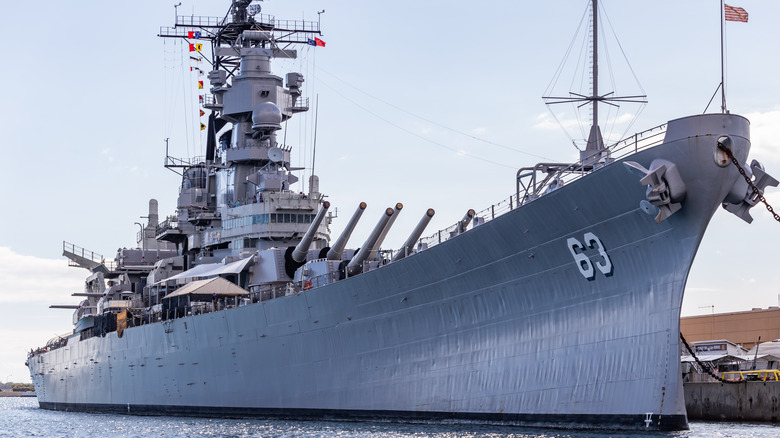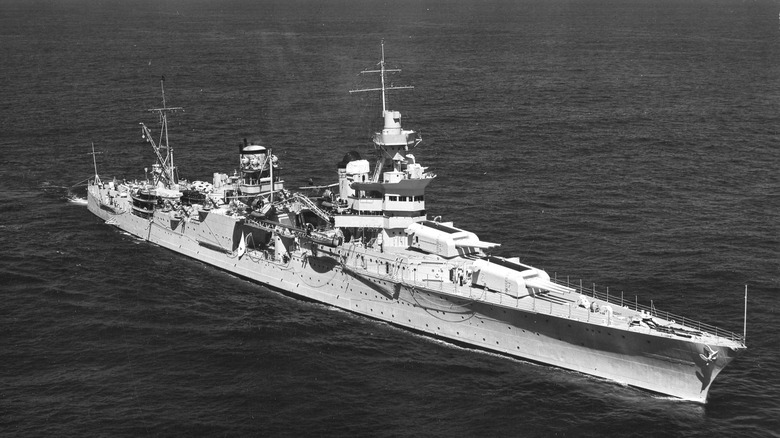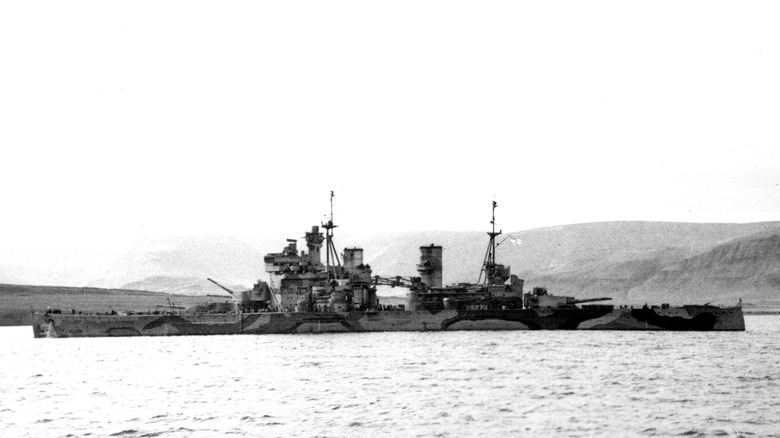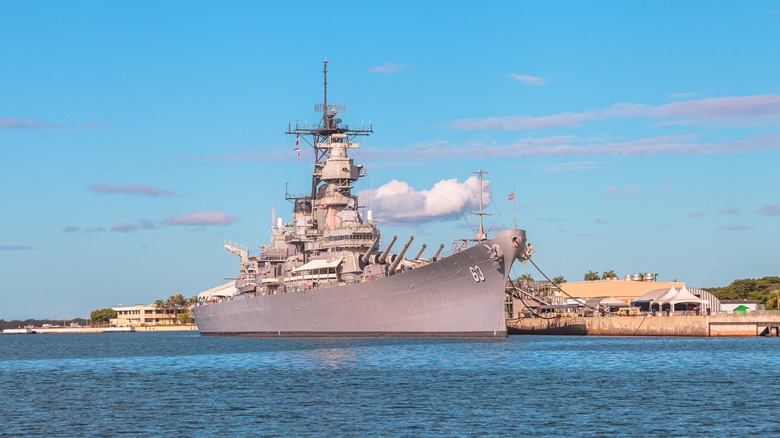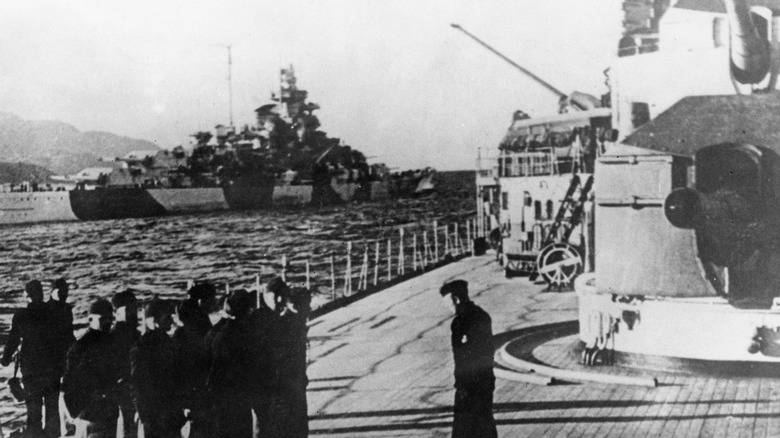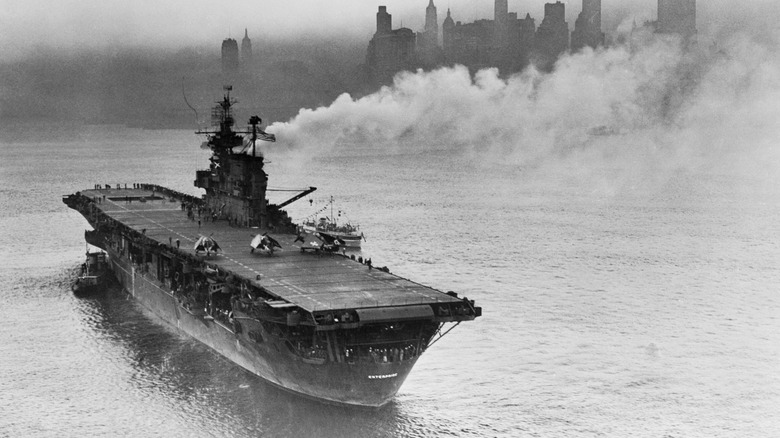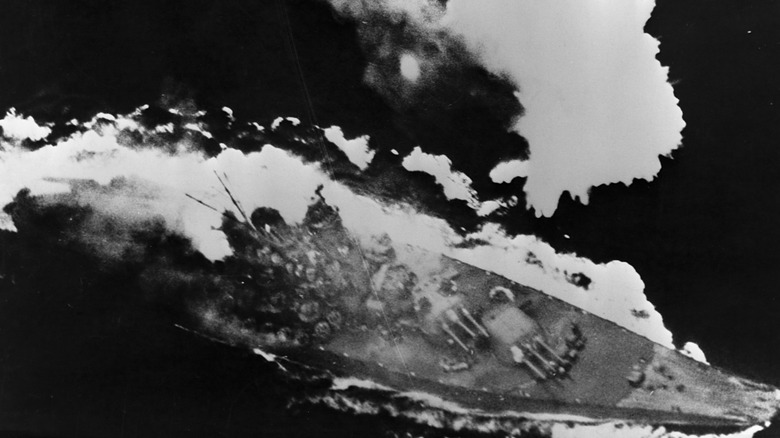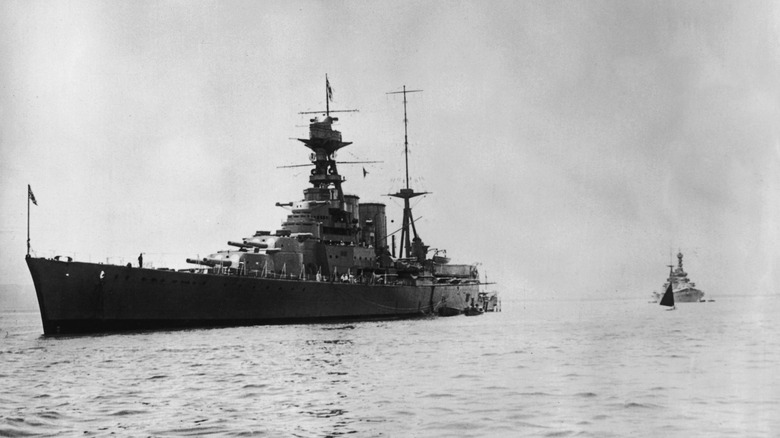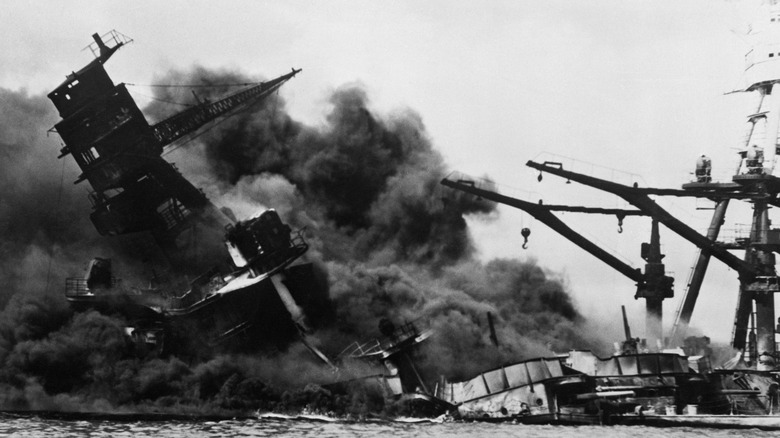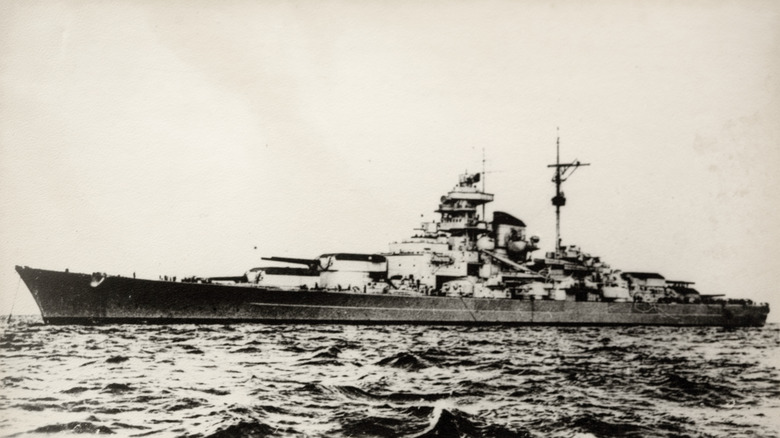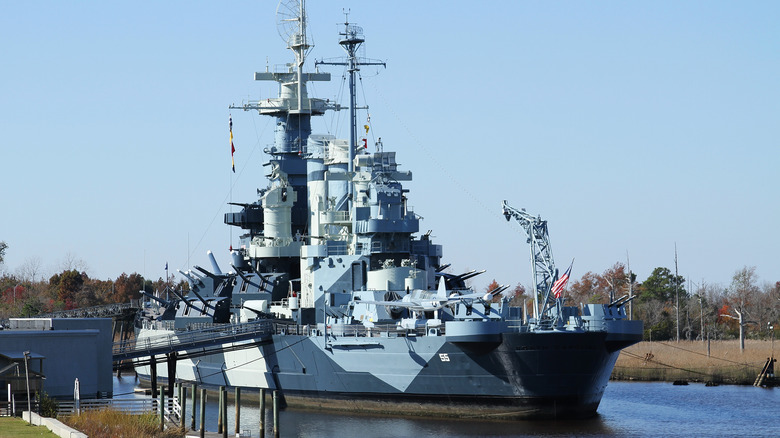The 10 Most Legendary Ships Of WW2 Ranked From Worst To Best
Ships played a crucial role in World War II, from large-scale engagements in the Atlantic and Pacific theaters of war to smaller clashes in the Arctic Ocean and the Mediterranean Sea. The various navies of each of the belligerents were vast and included aircraft carriers, battleships, cruisers, destroyers, frigates, and other auxiliary vessels. These ships were as indispensable as they were versatile, performing roles such as shore bombardment, anti-aircraft defense, blockades, security, carrier, escort, and transport duties.
Without the power and practical uses associated with warships, World War II would have been fought very differently. For instance, aircraft carriers were essential for the attack on Pearl Harbor, without which the United States would not necessarily have entered the war, and they continued to play a vital role in the battle for the Pacific. Throughout the war, convoys protecting Atlantic supply routes were under the continued threat of U-boat attacks from the deep. Success was critical to supporting the Allied campaign, and without dominance in the Atlantic, the war could have been lost.
At the time of the outbreak of World War II, the Royal Navy was the largest in the world by some margin. However, as the war dragged on, the Americans were galvanized by the war effort, and the U.S. Navy eventually outnumbered the British and Commonwealth fleet, with Japan and the Soviet Union also boosting their warship production significantly. The following are the most influential ships of World War II, ranked considering their firepower, performance, and historical significance.
10. USS Indianapolis
Heavy cruisers were long-range, high-speed ships that carried significant firepower, and the USS Indianapolis was a Portland-class example that played an essential role in the outcome of World War II. One of its final missions was to deliver components for the atomic bombs that would be dropped on Japan in the last days of the war, but the fateful story of the Indianapolis didn't end there.
As the flagship of the U.S. Fifth Fleet, the Indianapolis was involved in many important conflicts in the Pacific theater, including the bombardment of Iwo Jima. Its speed and power made it the ideal vessel to carry the infamous atomic bombs from San Francisco to the Mariana Islands. Having successfully completed its secret mission in 10 days, it was en route to the Philippines when, on July 30, 1945, it was struck by torpedoes from a Japanese submarine.
Around 900 men survived the sinking, but what followed was unimaginable terror as sharks feasted on many of the survivors, picking the dehydrated and emaciated crew off one by one over the course of three days in what must have been one of the most macabre and terrifying lotteries ever experienced. This tale was famously retold by Robert Shaw's character in the movie "Jaws" and was one of the last naval tragedies of World War II. Ultimately, only 317 survived.
9. HMS Prince of Wales
The HMS Prince of Wales was a King George V-class battleship that was the most advanced in the British fleet. Its armament consisted of ten 14-inch guns, sixteen 5.25-inch guns, and over thirty pom-pom antiaircraft guns. It was also equipped with the latest rangefinder and radar technology. Additionally, it carried two Walrus seaplanes for spotting and reconnaissance purposes.
The Price of Wales had a storied history throughout the early stages of World War II, first in the Battle of the Atlantic, where it sustained significant damages due to a Luftwaffe bombing. Following its repairs, it was sent to Scandinavia in 1941, where, along with HMS Hood, it was sent to pursue the notorious Bismarck, the flagship of the German fleet. Having carried the British Prime Minister Winston Churchill across the Atlantic for talks with President Roosevelt, it was dispatched to Singapore to engage with the Japanese.
Despite its superior technology and firepower, the HMS Prince of Wales was destroyed east of Malaysia in 1941. Nine Japanese torpedo bombers flew south from South-East Asia, attacking the ship several times in repeated assaults. Having succumbed to multiple torpedo strikes, it sank beneath the surface with the loss of 327 of its approximate 1,600 crew, despite a last-minute rescue attempt from a British destroyer.
8. USS Missouri
The USS Missouri, or Mighty Mo, is one of the most famous battleships still afloat. It is a 45,000-ton Iowa-class battleship commissioned in 1944. It was well-equipped as one of the most modern ships to serve in the conflict. At over 887 feet long and 108 feet wide, it was enormous, yet it could reach a top speed of 33 knots. Its firepower was equally impressive, with nine 16-inch guns, 20 5-inch guns, 80 40-millimeter guns, and 49 20-millimeter guns in its arsenal.
Being late to the party, the Missouri served in the Pacific theater in the assault on Iwo Jima and the Japanese islands before arriving in Tokyo Bay as the Third Fleet Flagship. This is where, on September 2nd, 1945, the ship hosted the signing of the Japanese surrender. This dignified ceremony was overseen by General Douglas Macarthur of the United States and other high-ranking officials on the deck of the USS Missouri, thus ending six long years of World War II.
The USS Missouri was the last American battleship ever built, and it went on to serve in the Korean War and Operation Desert Storm. It has since been honorably retired at Pearl Harbor, where it is a museum piece that attracts scores of visitors daily. It did, however, have one final role to play as the setting for Cher's video for the 1989 song "If I Could Turn Back Time" — a perhaps ill-advised chapter in an otherwise noble history.
7. Tirpitz
The German Bismarck-class Tirpitz was an absolute behemoth and a scourge of the Atlantic theater of war. It was so heavily armored that it survived multiple Allied attacks, including a few direct hits, and simply wouldn't succumb to its damages. It became a major thorn in Churchill's side as he obsessed over the destruction of Hitler's trophy battleship, referring to it as a prize that could not be won.
The Tirpitz significantly disrupted Allied Atlantic supply lines during the war. With its armor plating that was over three inches thick on its deck and over thirteen inches thick on its conning tower, some started to believe it was indestructible. It was heavily armed, with eight 38-centimeter guns, 12 15-centimeter guns, 52 smaller caliber guns, and eight torpedo tubes, making the hulk of a ship capable of severe destruction.
After many attempts to put the Tirpitz out of action, the ship was finally sunk by RAF bombers on November 12th, 1944. Yet it was as much attributed to luck as it was skill, as a squadron of Lancasters was afforded unseasonably clear conditions on the Norwegian coast while enemy fighters were diverted by communication errors from countering the attack. Like the Grendel monster of Scandinavian lore, Hitler's beast lay dead.
6. USS Enterprise
Dubbed the Big E for its considerable size and formidable reputation, the USS Enterprise CV-6 was the seventh Enterprise in a long lineage dating back to 1775. It was undoubtedly the most famous of its namesake ships, having been involved in almost all significant engagements in the Pacific. As the most decorated ship of World War II, it was among the most legendary that ever sailed, eventually lending its name to its successor, the nuclear-powered USS Enterprise CVN-65, as well as a starship in a popular science-fiction franchise.
The USS Enterprise was one of three Yorktown-class carriers notable for their seaworthiness and strength, incorporating many watertight compartments to limit battle damage, even after torpedo attacks. It initially displaced 25,500 tons when fully loaded, but after a refit in 1943, this was increased to over 32,000 tons, and it measured over 827 feet long by 114 feet wide. It held around 1.5 million gallons of fuel, carried 178,000 gallons of aviation gas, and had a range of over 10,000 nautical miles.
Equally impressive was the Enterprise's aircraft capacity, typically carrying between 80 and 90 planes, with a maximum capacity of 96, making this a precious asset to the U.S. Navy. It was present at the attack on Pearl Harbor, Guadalcanal, the Battle of Midway, the Battle of Leyte Gulf, and the Battle of the Philippine Sea. Yet the lauded aircraft carrier did not outlive the war by long, having been decommissioned in 1947 and scrapped by 1960.
5. Yamato
By the outbreak of World War II, battleships had come to symbolize a nation's strength in the face of its enemy, and no other vessel embodied the might of the Imperial Japanese Navy like the Yamato. As its flagship, the Yamato was already under construction by the time the Navy attacked Pearl Harbor. By its launch, it was bigger than any of its U.S. counterparts, even eclipsing the massive USS Iowa at 65,000 tons compared to 45,000 for the pride of America's fleet.
This leviathan was as well-equipped as its size would suggest, and the Yamato had the biggest guns ever built for a warship with 18.1-inch calibers, complemented by an array of 5-inch and 6-inch guns as well as anti-aircraft artillery. Having signed the Washington Treaty in 1922, the U.S. Navy's guns were limited in size, but this did not apply to Japan, as it had exited the treaty four years before the outbreak of World War II.
The Yamato had significant cultural relevance and was used sparingly by the Japanese as they were cautious not to rock the nation's pride. To lose it would gravely affect national morale, yet ultimately, this was to be the case. On April 1st, 1945, after having served in the Leyte Gulf in the Philippines, it was en route to Okinawa as part of Operation Ten-Go when a swarm of planes from the U.S. carrier fleet attacked. On April 1st, 1945, the Yamato succumbed to multiple bomb and torpedo strikes, sinking with the loss of more than 2,500 lives onboard.
4. HMS Hood
By the time of World War II, the battlecruiser HMS Hood was almost two decades old, having been completed in 1920. The Hood was a relatively early casualty of the war but is remembered as having partaken in one of the most notorious engagements in naval history. As the flagship of the British fleet, the loss of the Hood galvanized the hunt for the German battleship Bismarck as retaliation for this devastating blow to national pride.
Although it was conceived in the middle of World War I, the Hood was remarkably well-appointed and must have been a marvel of modern engineering at the time of its launch. It displaced 41,200 tons and was 860 feet long by 104 feet wide. Its armor plating accounted for 13,550 tons of its weight and was almost two inches thick in places. Not only could it take a beating, it could deliver one as well, with an armament consisting of eight 15-inch guns and twelve 5.5-inch guns, as well as an anti-aircraft battery.
As with many ships that served in World War II, the HMS Hood's demise was not pleasant. Outmaneuvered by the German Navy, it was sunk by the formidable Bismarck near the United Kingdom on May 24th, 1941, killing all but three of its 1,400 crew. Now the race was on to find and subdue Germany's star battleship as the Allies fought to maintain a footing in the battle for control of the seas.
3. USS Arizona
At around 8 am on December 7th, 1941, the Japanese gave the signal to attack Pearl Harbor. Upon hearing the signal "Tora, Tora, Tora," multiple planes took to the skies over Hawaii and unleashed their deadly payload on the unsuspecting U.S. Navy fleet at anchor. At this time, the USS Arizona was tethered to a repair ship and unready for combat when — all of a sudden — mayhem rained from above.
Like the HMS Hood, the USS Arizona was an early casualty of the war. Upon inspection, it appeared that the vessel had been struck by horizontal bombers, not by a torpedo, as initially thought. A massive blast occurred beneath the decks as the Arizona's magazine exploded, devastating the ship and killing over 1,100 of its crew as it sank to the bottom of the harbor, where it continued to burn for days.
Thus, the USS Arizona never actively served in World War II but was instrumental in the United States becoming a major Allied power as it entered the war immediately after the Japanese attack on Pearl Harbor, in which the ship accounted for half of the lives lost. It is now a national monument to the sacrifices of U.S. troops during World War II.
2. Bismarck
The Bismarck was the flagship of Germany and its most famous warship. Named after 19th-century politician Count Otto Von Bismarck, the Iron Chancellor, the ship was conceived in 1934 at a time when there were strict limitations on German naval tonnage, as a result of the Treaty of Versailles. Hitler denounced the treaty and greenlit the project for a mammoth battleship to flex Germany's power on the world stage, and the Bismarck was born to spearhead its naval fleet.
It was indeed large, with a maximum displacement of 41,700 tons, a length of more than 790 feet, and a width of 118 feet. It was also heavily armored, with plating that was as much as one foot thick in places. The Bismarck's armaments consisted of eight main guns with 15-inch calibers, 12 secondary six-inch guns, and a large battery of anti-aircraft guns to repel attacks from above.
The Bismarck was sunk by the British in 1941 in a massive boost to national morale, just hours after Germany sank its own flagship, HMS Hood. In a devastating blow to the German naval fleet, over two-thousand crew lost their lives after the vessel plunged to a depth of over 15,000 feet. Yet another gravesite was added to the growing number that littered the floor of the frigid Atlantic Ocean throughout World War II.
1. USS North Carolina
Commissioned in April 1941 before Japan's surprise attack dragged the United States into the war, the USS North Carolina was the first battleship added to the fleet in nearly twenty years. This proved to be a timely decision on the part of the U.S., and as the lead ship in its class, it was quickly put to work in the Pacific theater of war, cutting its teeth in the grueling Guadalcanal campaign.
The North Carolina class of battleships have a fully-loaded displacement of almost 45,000 tons. It was (and remains) 728 feet long, with a beam of 108 feet. It had armor of up to 16 inches in thickness, and its armament consisted of nine 16-inch main guns, 20 secondary 5-inch dual-purpose guns, and 16 anti-aircraft guns.
The North Carolina remained in the Pacific for the duration of World War II, where it was instrumental in several successful operations, including at Guadalcanal and Tulagi, the Marshall Islands, the Gilbert Islands, Leyte and Luzon in the Philippines, the assault on Iwo Jima, and Okinawa. As one of the most famous ships to grace the U.S. fleet, the North Carolina was notable for its resilience during the war. It is now a museum piece in Wilmington, North Carolina, and was graciously spared the destruction faced by so many ships of all navies, instead serving as a monument to the essential role that ships played during this dark episode in human history.
